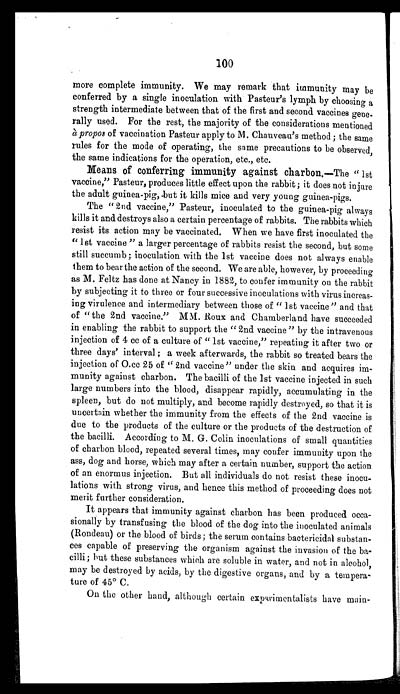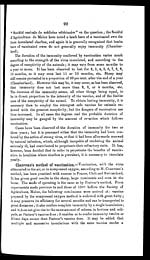Medicine - Veterinary > Civil Veterinary Departments > Civil Veterinary Department ledger series I-VI > Volume II - Anthrax
(294) Page 100
Download files
Individual page:
Thumbnail gallery: Grid view | List view

100
more complete immunity. We may remark that immunity may be
conferred by a single inoculation with Pasteur's lymph by choosing a
strength intermediate between that of the first and second vaccines gene-
rally used. For the rest, the majority of the considerations mentioned
à propos of vaccination Pasteur apply to M. Chauveau's method; the same
rules for the mode of operating, the same precautions to be observed,
the same indications for the operation, etc., etc.
Means of conferring immunity against charbon.—The "1st
vaccine," Pasteur, produces little effect upon the rabbit; it does not injure
the adult guinea-pig, but it kills mice and very young guinea-pigs.
The "2nd vaccine," Pasteur, inoculated to the guinea-pig always
kills it and destroys also a certain percentage of rabbits. The rabbits which
resist its action may be vaccinated. When we have first inoculated the
"1st vaccine" a larger percentage of rabbits resist the second, but some
still succumb; inoculation with the 1st vaccine does not always enable
them to bear the action of the second. We are able, however, by proceeding
as M. Feltz has done at Nancy in 1882, to confer immunity on the rabbit
by subjecting it to three or four successive inoculations with virus increas-
ing virulence and intermediary between those of "1st vaccine" and that
of "the 2nd vaccine." MM. Roux and Chamberland have succeeded
in enabling the rabbit to support the "2nd vaccine" by the intravenous
injection of 4 cc of a culture of "1st vaccine," repeating it after two or
three days' interval; a week afterwards, the rabbit so treated bears the
injection of O.cc 25 of "2nd vaccine" under the skin and acquires im-
munity against charbon. The bacilli of the 1st vaccine injected in such
large numbers into the blood, disappear rapidly, accumulating in the
spleen, but do not multiply, and become rapidly destroyed, so that it is
uncertain whether the immunity from the effects of the 2nd vaccine is
due to the products of the culture or the products of the destruction of
the bacilli. According to M. G. Colin inoculations of small quantities
of charbon blood, repeated several times, may confer immunity upon the
ass, dog and horse, which may after a certain number, support the action
of an enormus injection. But all individuals do not resist these inocu-
lations with strong virus, and hence this method of proceeding does not
merit further consideration.
It appears that immunity against charbon has been produced occa-
sionally by transfusing the blood of the dog into the inoculated animals
(Rondeau) or the blood of birds; the serum contains bactericidal substan-
ces capable of preserving the organism against the invasion of the ba-
cilli; but these substances which are soluble in water, and not in alcohol,
may be destroyed by acids, by the digestive organs, and by a tempera-
ture of 45° C.
On the other hand, although certain experimentalists have main-
Set display mode to: Large image | Zoom image | Transcription
Images and transcriptions on this page, including medium image downloads, may be used under the Creative Commons Attribution 4.0 International Licence unless otherwise stated. ![]()
| India Papers > Medicine - Veterinary > Civil Veterinary Departments > Civil Veterinary Department ledger series I-VI > Anthrax > (294) Page 100 |
|---|
| Permanent URL | https://digital.nls.uk/75516775 |
|---|




